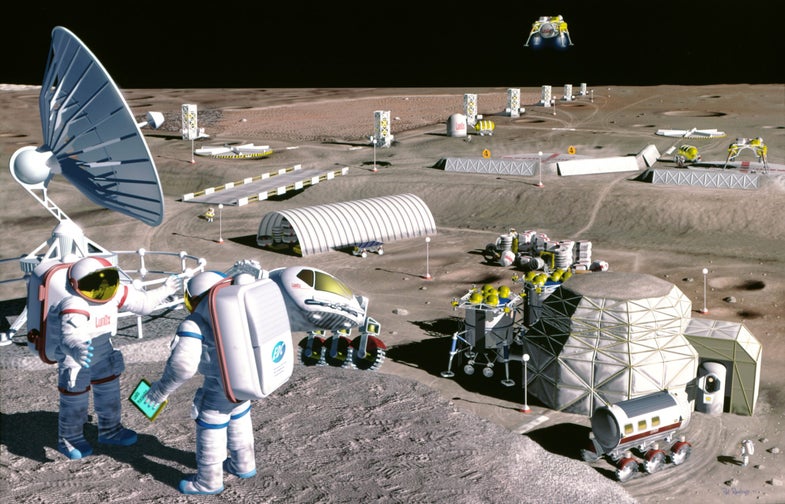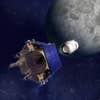Colonizing The Moon May Be 90 Percent Cheaper Than We Thought
And that in turn could help us get to Mars, says NASA-commissioned study

Only 12 people have walked on the moon, and we haven’t been back since 1972. But a new NASA-commission study has found that we can now afford to set up a permanent base on the moon, by mining for lunar resources and partnering with private companies.
Returning humans to the moon could cost 90 percent less than expected, bringing estimated costs down from $100 billion to $10 billion. That’s something that NASA could afford on its current deep space human spaceflight budget.
“A factor of ten reduction in cost changes everything,” said Mark Hopkins, executive committee chair of the National Space Society, in a press release.
The study, released today, was conducted by the National Space Society and the Space Frontier Foundation—two non-profit organizations that advocate building human settlements beyond Earth—and it was reviewed by an independent team of former NASA executives, astronauts, and space policy experts.
“A factor of ten reduction in cost changes everything.”
To dramatically reduce costs, NASA would have to take advantage of private and international partnerships—perhaps one of which would be the European Space Agency, whose director recently announced that he wants to build a town on the moon. The new estimates also assume that Boeing and SpaceX, NASA’s commercial crew partners, will be involved and competing for contracts. SpaceX famously spent just $443 million developing its Falcon 9 rocket and Dragon crew capsule, where NASA would have spent $4 billion. The authors of the new report are hoping that 89 percent discount will extend beyond low Earth orbit as well.
Similar to SpaceX’s goals of creating a reusable rocket, the plan also relies on the development of reusable spacecraft and lunar landers to reduce costs.
Plus, mining fuel from the lunar surface could make going back to the moon economically viable. Data from the Lunar Crater Observation and Sensing Satellite (LCROSS) suggest that water ice may be plentiful on the moon, especially near the poles. That’s important because water can be broken down into hydrogen and oxygen; hydrogen is a rocket propellant, and oxygen helps out in the combustion process. (Leftover oxygen would also, conveniently, provide breathing air for astronauts.)

Dive Bombing The Moon
The report envisions setting up a lunar industrial base that mines water from the lunar regolith, processes it into hydrogen, then sends the hydrogen into orbit around the moon so that spacecraft on their way to Mars (or elsewhere in the solar system) can stop by to get a fuel boost. Such an endeavor could shave off $10 billion per year in the cost of getting to the red planet. The report estimates that this industrial base would house four astronauts, and within 12 years of the initial landings, provide 200 megatons of propellant at a total cost of $40 billion.
How To Build A Lunar Mining Town
Here’s the specific proposal, as laid out in the report:
Phase 1
Robots determine how much hydrogen is in the lunar crust, and where it’s located. (Note: this step is crucial. If hydrogen is not plentiful and easy to mine from the lunar crust, then the plan to return to the moon is not viable.) One such robot has been proposed by NASA scientists. The Resource Prospector would deploy a rover that can search for hydrogen, drill into the lunar regolith, and heat samples to see what’s inside. If the mission gets funded, it’ll be the first mining expedition on another world.
Develop reusable spacecraft to get humans to and from the moon
Land humans at the equator, probably using SpaceX’s Falcon Heavy rocket, which is still in development but estimated to cost $1700 per kilogram
Phase 2
Develop technologies to mine the lunar ice
Develop reusable lunar lander to carry equipment back and forth from lunar orbit to lunar surface
Send humans to the lunar poles
Select a site for mining
Phase 3
Use lunar lander to deliver Bigelow Aerospace inflatable space habitats to lunar surface for human occupation. The habitat modules could be located in a lava tube for protection against radiation.
Deliver a crew of four astronauts to live on the surface and assist in repair of the largely autonomous mining equipment.
Begin mining for hydrogen
Lunar lander delivers 200 metric tons of propellant per year to a depot at Lagrange point L2–a stationary spot in lunar orbit on the far side of the Moon
The plan calls for mining and transport technologies that do not currently exist, but they’re within the realm of possibility. “There are no show-stoppers,” said Hoyt Davidson from Near Earth LLC during yesterday’s press conference. “There are certainly more things that need to be studied, and issues that need to be addressed.”

Robo Prospector
A Highway To Mars, And Beyond
In 1962, President John F. Kennedy famously said, “We choose to go to the moon in this decade and do the other things, not because they are easy, but because they are hard.”
Well, now that the Apollo program, Skylab, the International Space Station, and NASA’s other endeavors have paved the way, it’s not so hard anymore, says Tom Moser, who was the lead engineer and program manager for Apollo and the International Space Station. “Returning to the moon is easy, it’s reasonable and affordable, and could be the pathway to Mars… But there has to be a will do it.”
A 2014 Human Spaceflight Report found that the best way to send astronauts to Mars is to learn how to live on the moon first, but NASA went ahead with a cheaper path—the Asteroid Redirect Mission, which is largely irrelevant to the goal of traveling to and surviving on Mars. While there have been a few attempts to return to the moon after the Apollo program, those proposals had price tags ranging from $100 billion to a trillion dollars, says Charles Miller, the new study’s principle investigator and leader of the Alliance for Space Development.
Up until now, there hasn’t been widespread public support for going back to the moon, partly because it’s always seemed so expensive, says Miller. “We think the idea that this has to cost $100 billion should die a quick death.”
If mining for lunar hydrogen can be economically viable, it could pave the way for utilizing other valuable resources, such as helium-3, as well as making moon tourism more economical. “Now and forever, the most valuable thing in space is people,” says Gary Oleson from the Space Frontier Foundation’s board of directors.
The ideas in the report are just concepts and recommendations at this point, and NASA has no commitment to follow through on them as far as we can tell. But mining the moon certainly has the potential to restructure space travel. Rockets launching from Earth would no longer have to lift off carrying fuel and water for long journeys. Instead, they could pull over at the moon to top off their tanks. Leaving lunar orbit is a lot easier than leaving Earth, so these lunar way stations could potentially lower the cost of spaceflight dramatically, opening up a highway to Mars … and beyond.
“A permanent lunar settlement should be a building block for settlement of the rest of the solar system,” says Davidson.
Update, 3:50pm: This article was updated with new information from a press conference.
Update, 7/21/2015: The article was updated with specific information about the plan, based on the 100-page report that was released on 7/20.
Correction, 7/31/2015: Updated to clarify that some of the oxygen produced from splitting water would be needed in the combustion of rocket fuel. It would also be used in other tasks. From the report: “The oxygen and hydrogen produced in this ISRU [in situ resource utilization] cycle will provide the necessary consumables for operating fuel cells for the robotic systems, air to breathe, water to drink and of course…propellant.”